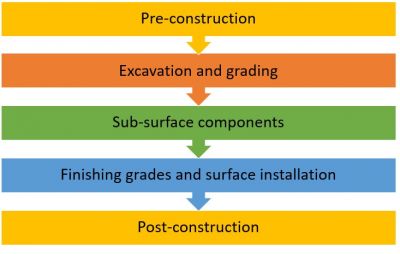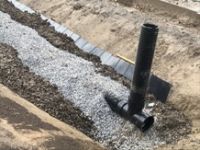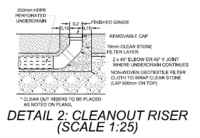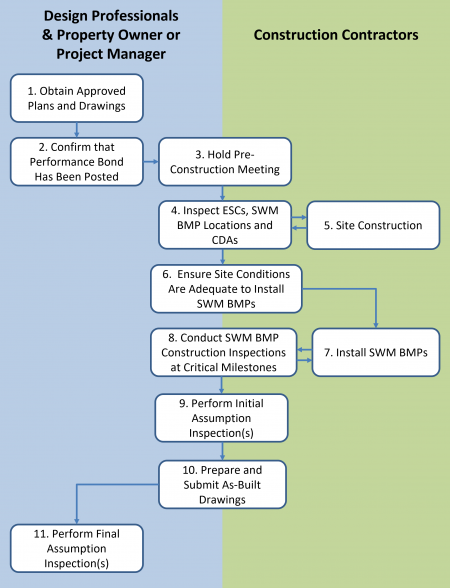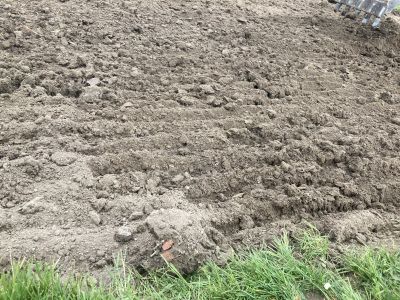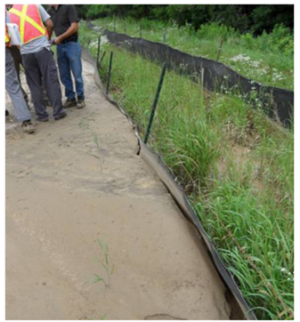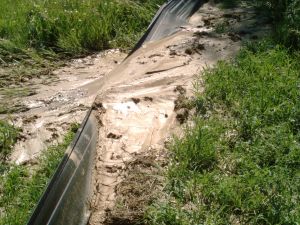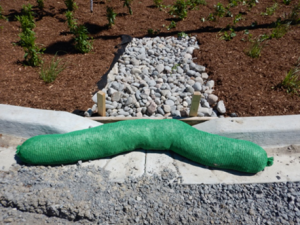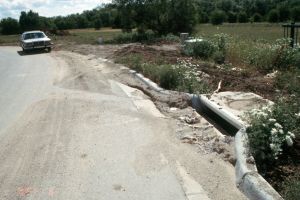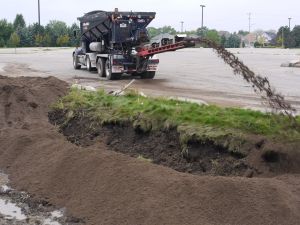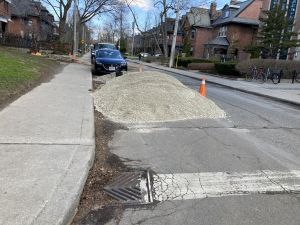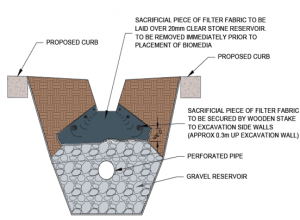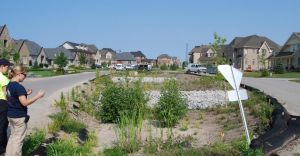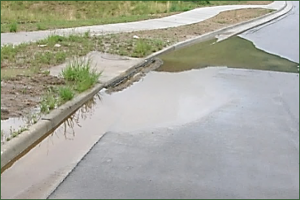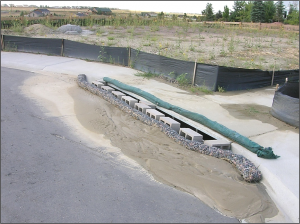Difference between revisions of "Pre-construction"
Kyle menken (talk | contribs) m |
|||
| (20 intermediate revisions by 2 users not shown) | |||
| Line 1: | Line 1: | ||
[[File:construction process.jpg|400px|thumb|right|The five-step construction process for sub-surface and ground-level LIDs.]] | |||
{{TOClimit|2}} | {{TOClimit|2}} | ||
==Overview== | ==Overview== | ||
[[ | The [[construction]] guidance in this section applies to all sub-surface and ground-level LID practices: [[bioretention|bioretention gardens]], [[bioswales]], [[rain gardens]], [[exfiltration trenches]], [[enhanced swales]], [[permeable pavements]], [[infiltration trenches]], [[infiltration chambers]], and [[soakaways]]. It was developed for project managers, engineers, and contractors on the pre-construction steps required for successful construction of sub-surface and ground-level LID practices. | ||
==Design verification and site walk-through== | ==Design verification and site walk-through== | ||
{ | When the design is 90% complete, the project manager (PM) should conduct a walk-through of the site to verify that the designs match site conditions. This site walk-through is a critical step in the transition from design to construction and helps the project manager plan for future pre-bid or pre-construction meetings. Think carefully about how a contractor will be able to build the LID practice. At this stage, determine if the design drawings and construction notes address specific LID construction requirements, and determine whether they contain inaccuracies or are missing detail. The table below identifies details key points and considerations for the walk-through. | ||
{|class="wikitable" | |||
|+ Design verification points and key considerations | |||
|- | |||
!Verification point | |||
!Key considerations | |||
|- | |||
|Adjacent land uses|| | |||
*Have land uses changed while the design was in progress? Are there any planned land-use changes on adjacent properties and is their drainage connected to the site? | |||
*Will adjacent land uses create dirty runoff that may flow onto the construction site or into the LID feature? | |||
*Is additional erosion and sediment control (ESC) measures required beyond what is marked in the ESC plan? | |||
|- | |||
|Contributing and receiving drainage areas|| | |||
*Where is water coming onto the site and where is water leaving the site? | |||
*Are any environmentally sensitive areas downstream? | |||
*Are there any apparent changes while the design was in progress? If so, should these changes motivate modifications to the design, particular ESC measures, etc.? | |||
|- | |||
|Seasonal maintenance operations|| | |||
*Will [[winter]] snow storage and [[salt]] or sand application impact the LID feature? | |||
|- | |||
|Location of LID features|| | |||
*Do the proposed LID locations match the site? | |||
*Does the footprint of the LID fit within the site's constraints? | |||
|- | |||
|Existing and planned infrastructure/utilities|| | |||
*Confirm accuracy of design drawings. | |||
*Are there any unmarked utilities not detailed within the drawing set? | |||
|- | |||
|Property boundaries and building foundations|| | |||
*Confirm accuracy of design drawings. | |||
*Do fence lines align with property boundaries? | |||
|- | |||
|Natural heritage features and existing vegetation || | |||
*Do the designs accurately capture existing natural heritage features? Which areas on the site should be protected during construction, and will these exclusion areas make the LID facility more difficult to construct? Where are the drip lines of the site's trees? | |||
*Are there any invasive species on the site which could colonize the LID practice? | |||
|- | |||
|Access, sequencing, staging, and constructability || | |||
*Where will the contractor access the site? | |||
*What is the ideal construction sequence, and where could materials and supplies be stored during construction? | |||
*Do site characteristics constrain standard construction practices? Will it be a difficult job? | |||
*Do constructability issues require a field change or amendment to the design or project tender? | |||
|} | |||
==LID construction notes== | ==LID construction notes== | ||
LID design drawings need detailed construction notes within the design drawings. These notes should include: | |||
*sequencing and staging areas | |||
*material specifications | |||
*testing requirements | |||
*installation procedures | |||
*elevations and invert details for inlet, outlet, and overflow features | |||
*grading details for conveyance features | |||
*erosion and sediment control requirements | |||
*[[inspection and maintenance]] responsibilities during construction and prior to assumption | |||
The last two bullets require further comment. LID facilities are most vulnerable to sedimentation and [[clogging]] during their own construction and construction of adjacent and connected lands. LID construction contracts should specify a sufficient combination of ESC measures and inspection and maintenance of the LID facility during the construction and assumption phases to ensure that it will function without remediation. Contracts for larger-scale projects, e.g., where the LID facility in question is part of a road reconstruction project or subdivision development, should contain clear terms covering responsibilities for keeping sediment from entering newly constructed LID features and removing it if necessary. | |||
==Tendering and contract== | ==Tendering and contract== | ||
The project contract and tendered drawings, including details, notes, ESC requirements, material specifications, and testing requirements should align. Given that most standard contract templates do not include wording specific to LID construction, considerations for LID can be placed under special provisions within the contract. | |||
Details within the drawings and contract should also be accurately reflected in the tender bid form. A detailed bid form that reflects the entirety of the work allows contractors to deliver accurate bids, lessens the likelihood of project shortcuts, and helps to ensure transparency amongst bids. Ultimately, clear bid pricing reduces the potential for misunderstandings and conflicts and attracts experienced contractors. | |||
===Minimum contractor requirements=== | |||
Many contractors are unfamiliar with building LID practices. Consider mandating contractor training, attendance at pre-bid meetings, LID project references, and bid bond insurance as prerequisites. | |||
==Communication, inspection plan, and utilities coordination== | ==Communication, inspection plan, and utilities coordination== | ||
{{: | {| class="wikitable floatright" style="width: 200px" | ||
|+ Be sure to verify all design changes | |||
|- | |||
|[[File:T-junction_photo.jpg|200px]][[File:Y-junction design detail.png|200px]] | |||
|- | |||
|A simple departure from the design—installing a T-junction (top) in place of a Y-junction (below) would have made it extremely difficult or impossible to inspect this underdrain and flush it out. (Image sources: CVC) | |||
|- | |||
|} | |||
</br> | |||
After securing a contractor, a pre-construction meeting between the project manager, project engineer, and contractor will facilitate an efficient job site and reduce the potential for miscommunication. These meetings should cover: | |||
*LID design details and construction notes | |||
*material specifications, inspections, and chain-of-custody | |||
*access routes and storage areas | |||
*protection of LID practices: phasing, ESC, and perimeter fencing | |||
*equipment requirements and recommendations | |||
*verification of field changes | |||
*plant establishment and warranty-period maintenance | |||
*ownership and assumption protocols | |||
*project inspection plan | |||
*verification processes for field changes to the design and material substitutions | |||
The table below expands upon the bullets above and provides helpful guidance on communication topics at the pre-construction meeting. Given the lead-up time needed for testing requirements of specified materials, these discussions should occur soon after the contract is awarded, ideally 2 months prior to project construction. | |||
{|class="wikitable" | |||
|+ Pre-construction communication topics | |||
|- | |||
!Communication topic | |||
!Guidance | |||
|- | |||
|'''LID design details and construction notes'''|| | |||
*Provide overview of LID design, ideally through a design brief. | |||
*Discuss LID design details and construction notes, and ensure details and notes are understood by all parties involved. | |||
*Discuss project phasing and general timeliness. | |||
|- | |||
|'''Material specifications, inspections, and chain-of-custody'''|| | |||
*Material substitutions must be confirmed by the project engineer. | |||
*Material testing requirements and their timelines must be understood by all parties, including who is responsible for testing. | |||
*Material acceptance protocols, with chain of custody, should be understood by all parties, including who is responsible if the material fails. | |||
*[[Bioretention: Filter media|Biomedia]] manufacturing and testing should start prior to construction, ideally 2 months in advance. | |||
|- | |||
|'''Access routes and storage areas'''|| | |||
*Discuss access to the site along with material and equipment storage with the contractor. | |||
*Material storage should be downstream of LID features. | |||
*Heavy equipment routes should be agreed on to minimize impact to the LID feature and protected areas. | |||
|- | |||
|'''Protection of LID practices during construction: phasing, ESC, and perimeter controls'''|| | |||
*Review and discuss the ESC plan. | |||
*Discuss frequency of ESC inspection, protocols for repair and replacement, and parties responsible. | |||
*Discuss communication protocols for sediment contamination. | |||
*Discuss rehabilitation protocols for sediment contamination and parties responsible. | |||
|- | |||
|'''Equipment requirements and recommendations'''|| | |||
*Wide track, low-ground pressure vehicles are recommended to minimize compaction. | |||
*Excavation should occur from outside of LID feature whenever possible. See Excavation. | |||
*Gravel and biomedia should be installed by a slinger truck outside of practice whenever possible. | |||
*Avoid heavy machinery within LID footprint whenever possible. | |||
|- | |||
|'''Verification of field changes'''|| | |||
*The project engineer must verify all field changes to materials and design. | |||
*In the design engineer’s absence, the project manager should verify field changes. | |||
|- | |||
|'''Plant establishment and warranty-period maintenance'''|| | |||
*Discuss [[Plant selection|planting]] timelines at the pre-construction meeting. | |||
*Avoid planting in the summer months (June, July and August). Fall planting is the ideal scenario. | |||
*Plants will require regular maintenance (irrigation and weeding) to ensure establishment, especially over the first year. | |||
*Ensure that plant maintenance and its frequency is understood by responsible parties. | |||
*Plant deficiencies should be addressed prior to warranty period initiating. | |||
|- | |||
|'''Ownership and assumption protocols'''|| | |||
*Discuss how testing will confirm LID practice functionality according to assumption protocols. | |||
|- | |||
|'''Project inspection plan'''|| | |||
*Project inspection plan should be detailed and understood by all parties. | |||
*Sign off by all parties involved on photos, video, and social media post may be required. | |||
|} | |||
===Inspection plan=== | |||
[[File:Construction duties flowchart.png|450px|right|Communication about inspection points between the owner, the engineer, and the contractor are critical for a successful project.]] | |||
The [[inspection and maintenance]] page gives detailed guidance on how to conduct construction inspections for LID practices. Generally, construction inspections should be continuous as the work progresses. If this isn’t possible, critical inspection points are: | |||
*site preparation | |||
*excavation | |||
*installation of pipes, granular, and biomedia | |||
*finishing grades | |||
*surface treatment installation: pavers, plants, porous concrete, etc. | |||
*after rain events (see ESC inspection and maintenance) | |||
*whenever sub-contractors or utilities begin work (hand-off points) | |||
The last element—inspection of sub-contractors—requires further comment. For example, if a sub-contractor is installing the curbing, they need to understand the purpose of the curbing and curb cuts, i.e., that they are meant to direct water into the LID facility, not to the closest catch basin. Without this knowledge, the sub-contractor may mistakenly build the curbs as they usually do: to direct water into a catchbasin. | |||
===Utilities coordination=== | |||
Similarly, if the LID practice is in close proximity to sub-surface utilities, the utility owner may use their own contractors to perform related work. If this is the case, these sub-contractors must also be made aware of the LID practice’s purpose, how compaction affects performance, keeping the LID practice clear of excavated dirt and generally how their work could impede the construction and performance of the LID practice. | |||
In general, communication between the contractors, project managers, and project engineers should be frequent and open. | |||
==Erosion and sediment control measures== | ==Erosion and sediment control measures== | ||
[[File:ESC perpendicular grooves.jpg|400px|thumb|right|Grooves perpendicular to the grade help prevent the development of rills. (Photo source: CVC, 2022)]] | |||
STEP's [https://sustainabletechnologies.ca/home/urban-runoff-green-infrastructure/healthy-soils/construction-specifications-for-implementing-compost-amended-planting-soil-in-ontario/ Erosion and Sediment Control Guide for Urban Construction]]<ref> STEP. 2019. Erosion and Sediment Control Guide for Urban Construction. https://sustainabletechnologies.ca/home/urban-runoff-green-infrastructure/healthy-soils/construction-specifications-for-implementing-compost-amended-planting-soil-in-ontario/</ref> contains detailed guidance on the design, installation, inspection, maintenance, and decommissioning of ESC measures. This section gives practical advice on structural and non-structural ESC for contractors, inspectors, and those who are new to construction and ESC practices. | |||
Establish required perimeter controls, including erosion and sediment control (ESC) measures, prior to construction and adjust accordingly during construction. ESC measures come in two basic types: structural ESC, which slows and holds runoff from the disturbed area, dissipating erosive forces, promoting ponding, and allowing suspended particles to settle out; and non-structural ESC, which primarily minimizes the exposure time of stripped soils. | |||
For non-structural ESC measures, be sure to: | |||
*Stage clearing and grubbing to minimize exposure of stripped soils. | |||
*Watch the weather and adjust plans accordingly. | |||
*Manage and demarcate heavy equipment routes away from LID practices. | |||
*Use simple, common-sense methods, such as scarifying exposed soils perpendicular to the grade to prevent the development of rills. | |||
*Create and use a [[pollution prevention]] plan for fuels or solvents. | |||
Generally, all exposed soils that are not being actively worked on must have temporary erosion protection or permanent cover within 7 days for slopes 3:1 or greater and 14 days for slopes 3:1 or lesser. This should apply to all exposed soil areas year-round and until the site is stabilized. | |||
The table below gives guidance on common mistakes made when installing structural ESC measures. | |||
{|class="wikitable" style="width: 1280px" | |||
|+'''Best practices and common errors when installing structural erosion and sediment control measures''' | |||
|- | |||
!style="width: 500px"|Structural ESC measure | |||
!style="width: 1500px"|Do | |||
!style="width: 1500px"|Don't | |||
!style="width: 500px"|<span style="color:green">('''Pass''')</span> Photo Example | |||
!style="width: 550px"|<span style="color:red">('''Fail''')</span> Photo Example | |||
|- | |||
|'''Sediment fencing''' | |||
| | |||
*Stake it in, support it, and double it up adjacent to natural heritage features. | |||
| | |||
*Leave vulnerable points with insufficient supports. | |||
|[[File:ESC doubled up.png|300px|thumb|center|This sediment fencing has been doubled up and staked in. As a result, it kept a large amount of sediment from entering the adjacent natural heritage feature. It is in need of immediate maintenance, however. (Photo source: CVC)]] | |||
|[[File:ESC insufficient support.JPG|300px|thumb|center|This sediment fencing was not staked in at the likely point of failure, resulting in the release of sediment into an adjacent natural heritage feature. (Photo Source: CISEC)]] | |||
|- | |||
|'''Inlet controls''' | |||
| | |||
*Support and stake in inlet controls such as sediment socks. | |||
*Use catch basin inserts as a final line of protection. | |||
| | |||
*Leave inlets to the stormwater management system unprotected or unsupported | |||
| | |||
[[File:ESC inlet supported.png|300px|thumb|center|This filter stock has been staked in and supported. (Source: CVC)]] | |||
| | |||
[[File:ESC curb inlet (sediment has entered).jpg|300px|thumb|center|This catch basin was left unprotected, resulting in the release of sediment into the stormwater management system. (Photo source: CISEC)]] | |||
|- | |||
|'''Stockpiles''' | |||
| | |||
*Sling soil and [[aggregates]] into the facility when possible. | |||
*Install soil and aggregates upon arrival to the site when possible. | |||
| | |||
*Store materials within the stormwater management system, e.g., in the roadway. | |||
*Leave stockpiles unprotected when wet weather is expected. | |||
| | |||
[[File:P1090179 SlingerTruck.JPG|300px|thumb|center|(Photo source: CVC)]] | |||
| | |||
[[File:Stockpile in gutter.jpg|300px|thumb|center|If it were to rain, fines from this stockpile would go straight into the downstream catchbasin. (Photo source: CVC)]] | |||
|- | |||
|'''Protecting features during construction, including using sacrificial filter fabric''' | |||
| | |||
*Use sacrificial [[filter fabric]] when necessary to protect features, and leave ESC measures in place until all construction in the LID's drainage area is complete. | |||
| | |||
*Remove ESC measures early or allow sediment to enter the LID footprint. | |||
| | |||
[[File:ESC sacrificial fabric.png|300px|thumb|center|]] | |||
| | |||
[[File:ESC premature removal.jpg|300px|thumb|center|ESC measures at this bioretention feature were removed before construction in its drainage was complete, allowing sediment into it.(Photo Source: CVC)]] | |||
|} | |||
==Erosion and sediment control inspection and maintenance== | ==Erosion and sediment control inspection and maintenance== | ||
ESC measures require ongoing attention to ensure integrity and performance. ESC inspections should take place, at minimum, during installation, after rainfall events, and at the critical inspection points discussed in the [[Pre-construction#Communication, inspection plan, and utilities coordination|Pre-construction: Communication, inspection plan, and utilities coordination]] | |||
At these inspections, keep an eye out for accumulated sediment, worn materials, compliance with the project's staging plan, and potential failure points. | |||
[[File:ESC ponding 2.png|300px|thumb|left|Ponding in front of this catchbasin indicates that this ESC inlet control is working. Ponding water allows for suspended sediments to settle. (Photo source: CISEC)]] | |||
[[File:ESC ponding 1.png|300px|thumb|center|This inlet control has worked well, but the sediment should be removed as soon as possible. (Photo source: CISEC)]]<br> | |||
==Mobilization, access, staging, and perimeter controls== | ==Mobilization, access, staging, and perimeter controls== | ||
In tandem with installation of ESC measures, setting up access and staging areas is one of the first steps in any construction project. Perimeter controls such as construction fencing are often combined with silt fencing. Safety fencing may be needed to restrict public access to the site, especially if the site sees lots of pedestrian traffic. Together, construction fencing and structural ESC measures should demarcate: | |||
*limits of construction | |||
*heavy equipment routes | |||
*equipment and material storage areas | |||
*LID practice footprints | |||
*natural heritage features | |||
*access areas | |||
'''Construction steps''' | |||
#Install perimeter fencing/sediment fence in alignment with design drawings and ESC plan. | |||
#Demarcate staging and access points with fencing or surface markings in alignment with design drawings. | |||
'''Key inspection points''' | |||
*Ensure perimeter fencing and access/staging areas are in alignment with design drawings. | |||
'''Mistakes to avoid''' | |||
*Departing from the plan to stage and limit access points, material storage areas, and equipment storage areas | |||
*Installing inadequate perimeter controls, e.g. inadequate sediment fencing or construction fencing | |||
==References== | |||
Latest revision as of 21:29, 22 September 2022
Overview[edit]
The construction guidance in this section applies to all sub-surface and ground-level LID practices: bioretention gardens, bioswales, rain gardens, exfiltration trenches, enhanced swales, permeable pavements, infiltration trenches, infiltration chambers, and soakaways. It was developed for project managers, engineers, and contractors on the pre-construction steps required for successful construction of sub-surface and ground-level LID practices.
Design verification and site walk-through[edit]
When the design is 90% complete, the project manager (PM) should conduct a walk-through of the site to verify that the designs match site conditions. This site walk-through is a critical step in the transition from design to construction and helps the project manager plan for future pre-bid or pre-construction meetings. Think carefully about how a contractor will be able to build the LID practice. At this stage, determine if the design drawings and construction notes address specific LID construction requirements, and determine whether they contain inaccuracies or are missing detail. The table below identifies details key points and considerations for the walk-through.
| Verification point | Key considerations |
|---|---|
| Adjacent land uses |
|
| Contributing and receiving drainage areas |
|
| Seasonal maintenance operations | |
| Location of LID features |
|
| Existing and planned infrastructure/utilities |
|
| Property boundaries and building foundations |
|
| Natural heritage features and existing vegetation |
|
| Access, sequencing, staging, and constructability |
|
LID construction notes[edit]
LID design drawings need detailed construction notes within the design drawings. These notes should include:
- sequencing and staging areas
- material specifications
- testing requirements
- installation procedures
- elevations and invert details for inlet, outlet, and overflow features
- grading details for conveyance features
- erosion and sediment control requirements
- inspection and maintenance responsibilities during construction and prior to assumption
The last two bullets require further comment. LID facilities are most vulnerable to sedimentation and clogging during their own construction and construction of adjacent and connected lands. LID construction contracts should specify a sufficient combination of ESC measures and inspection and maintenance of the LID facility during the construction and assumption phases to ensure that it will function without remediation. Contracts for larger-scale projects, e.g., where the LID facility in question is part of a road reconstruction project or subdivision development, should contain clear terms covering responsibilities for keeping sediment from entering newly constructed LID features and removing it if necessary.
Tendering and contract[edit]
The project contract and tendered drawings, including details, notes, ESC requirements, material specifications, and testing requirements should align. Given that most standard contract templates do not include wording specific to LID construction, considerations for LID can be placed under special provisions within the contract.
Details within the drawings and contract should also be accurately reflected in the tender bid form. A detailed bid form that reflects the entirety of the work allows contractors to deliver accurate bids, lessens the likelihood of project shortcuts, and helps to ensure transparency amongst bids. Ultimately, clear bid pricing reduces the potential for misunderstandings and conflicts and attracts experienced contractors.
Minimum contractor requirements[edit]
Many contractors are unfamiliar with building LID practices. Consider mandating contractor training, attendance at pre-bid meetings, LID project references, and bid bond insurance as prerequisites.
Communication, inspection plan, and utilities coordination[edit]
After securing a contractor, a pre-construction meeting between the project manager, project engineer, and contractor will facilitate an efficient job site and reduce the potential for miscommunication. These meetings should cover:
- LID design details and construction notes
- material specifications, inspections, and chain-of-custody
- access routes and storage areas
- protection of LID practices: phasing, ESC, and perimeter fencing
- equipment requirements and recommendations
- verification of field changes
- plant establishment and warranty-period maintenance
- ownership and assumption protocols
- project inspection plan
- verification processes for field changes to the design and material substitutions
The table below expands upon the bullets above and provides helpful guidance on communication topics at the pre-construction meeting. Given the lead-up time needed for testing requirements of specified materials, these discussions should occur soon after the contract is awarded, ideally 2 months prior to project construction.
| Communication topic | Guidance |
|---|---|
| LID design details and construction notes |
|
| Material specifications, inspections, and chain-of-custody |
|
| Access routes and storage areas |
|
| Protection of LID practices during construction: phasing, ESC, and perimeter controls |
|
| Equipment requirements and recommendations |
|
| Verification of field changes |
|
| Plant establishment and warranty-period maintenance |
|
| Ownership and assumption protocols |
|
| Project inspection plan |
|
Inspection plan[edit]
The inspection and maintenance page gives detailed guidance on how to conduct construction inspections for LID practices. Generally, construction inspections should be continuous as the work progresses. If this isn’t possible, critical inspection points are:
- site preparation
- excavation
- installation of pipes, granular, and biomedia
- finishing grades
- surface treatment installation: pavers, plants, porous concrete, etc.
- after rain events (see ESC inspection and maintenance)
- whenever sub-contractors or utilities begin work (hand-off points)
The last element—inspection of sub-contractors—requires further comment. For example, if a sub-contractor is installing the curbing, they need to understand the purpose of the curbing and curb cuts, i.e., that they are meant to direct water into the LID facility, not to the closest catch basin. Without this knowledge, the sub-contractor may mistakenly build the curbs as they usually do: to direct water into a catchbasin.
Utilities coordination[edit]
Similarly, if the LID practice is in close proximity to sub-surface utilities, the utility owner may use their own contractors to perform related work. If this is the case, these sub-contractors must also be made aware of the LID practice’s purpose, how compaction affects performance, keeping the LID practice clear of excavated dirt and generally how their work could impede the construction and performance of the LID practice. In general, communication between the contractors, project managers, and project engineers should be frequent and open.
Erosion and sediment control measures[edit]
STEP's Erosion and Sediment Control Guide for Urban Construction][1] contains detailed guidance on the design, installation, inspection, maintenance, and decommissioning of ESC measures. This section gives practical advice on structural and non-structural ESC for contractors, inspectors, and those who are new to construction and ESC practices.
Establish required perimeter controls, including erosion and sediment control (ESC) measures, prior to construction and adjust accordingly during construction. ESC measures come in two basic types: structural ESC, which slows and holds runoff from the disturbed area, dissipating erosive forces, promoting ponding, and allowing suspended particles to settle out; and non-structural ESC, which primarily minimizes the exposure time of stripped soils.
For non-structural ESC measures, be sure to:
- Stage clearing and grubbing to minimize exposure of stripped soils.
- Watch the weather and adjust plans accordingly.
- Manage and demarcate heavy equipment routes away from LID practices.
- Use simple, common-sense methods, such as scarifying exposed soils perpendicular to the grade to prevent the development of rills.
- Create and use a pollution prevention plan for fuels or solvents.
Generally, all exposed soils that are not being actively worked on must have temporary erosion protection or permanent cover within 7 days for slopes 3:1 or greater and 14 days for slopes 3:1 or lesser. This should apply to all exposed soil areas year-round and until the site is stabilized.
The table below gives guidance on common mistakes made when installing structural ESC measures.
| Structural ESC measure | Do | Don't | (Pass) Photo Example | (Fail) Photo Example |
|---|---|---|---|---|
| Sediment fencing |
|
|
||
| Inlet controls |
|
|
||
| Stockpiles |
|
|
||
| Protecting features during construction, including using sacrificial filter fabric |
|
|
Erosion and sediment control inspection and maintenance[edit]
ESC measures require ongoing attention to ensure integrity and performance. ESC inspections should take place, at minimum, during installation, after rainfall events, and at the critical inspection points discussed in the Pre-construction: Communication, inspection plan, and utilities coordination
At these inspections, keep an eye out for accumulated sediment, worn materials, compliance with the project's staging plan, and potential failure points.
Mobilization, access, staging, and perimeter controls[edit]
In tandem with installation of ESC measures, setting up access and staging areas is one of the first steps in any construction project. Perimeter controls such as construction fencing are often combined with silt fencing. Safety fencing may be needed to restrict public access to the site, especially if the site sees lots of pedestrian traffic. Together, construction fencing and structural ESC measures should demarcate:
- limits of construction
- heavy equipment routes
- equipment and material storage areas
- LID practice footprints
- natural heritage features
- access areas
Construction steps
- Install perimeter fencing/sediment fence in alignment with design drawings and ESC plan.
- Demarcate staging and access points with fencing or surface markings in alignment with design drawings.
Key inspection points
- Ensure perimeter fencing and access/staging areas are in alignment with design drawings.
Mistakes to avoid
- Departing from the plan to stage and limit access points, material storage areas, and equipment storage areas
- Installing inadequate perimeter controls, e.g. inadequate sediment fencing or construction fencing
References[edit]
- ↑ STEP. 2019. Erosion and Sediment Control Guide for Urban Construction. https://sustainabletechnologies.ca/home/urban-runoff-green-infrastructure/healthy-soils/construction-specifications-for-implementing-compost-amended-planting-soil-in-ontario/
